Native Son: HED Gone with the Wind

Prior to opening, the “inflated” balloon flower bud. All photos by Steven Chamblee.
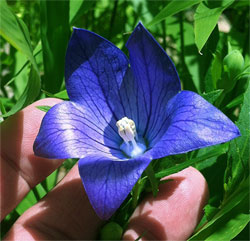
The same flower 45 minutes later, after opening.
So I’m pulling weeds in the garden, gazing upon a nearby balloon flower (Platycodon grandiflorus) and letting my mind drift away into the ether, when I get to thinking about the hot air balloon in The Wizard of Oz, which led to the animated movie Up, which led me to wonder if you tied, say, a million balloon flowers together, could you make a flying floral contraption? I can think of lots of reasons why plants might want to fly … to visit the in-laws in Boise, sightsee the castles in Scotland, hang a prayer flag off K2 … but can they do it? I mean, why not? (We’re not talking about wind-borne pollen here, but plants themselves.) Plants live beside, in, and under water … inhabit the driest deserts in the world … grow on top of mountains … hang off sheer cliffs and fall into caves … why not fly?
Some voice in my head says, “Because it ain’t natural.” Well, neither is packing 300 people in a metal tube and propelling it halfway around the world non-stop, but it happens with alarming regularity … so hush up.

Damp with morning dew, this dandelion “poofie” shows its individual components.
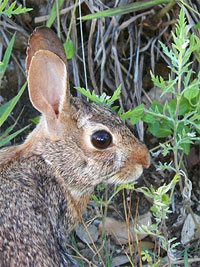
Peter Rabbit watches Steven pull weeds nearby.
About this time, a dandelion appears before my weeding fingers, and as any gardener can attest, a single dandelion “poofie” (technically a spherical infructescence of capillary-bristled achenes … so, like I said, a “poofie”) can spread millions of seeds for thousands of miles. (Another interesting side note: a dandelion in your own garden is an edible herb, while the same plant in your neighbor’s yard is an abomination worthy of legal remediation.) This “poofie” actually contains a few dozen seeds, each attached to a little “parachute” that catches wind and floats to a new destination. So, these seeds don’t actually fly, they simply use air to move. Turns out, there’s a swanky word for this phenomenon: anemochory (“uh-NEM-uh-core-ee”).
Lots of plant seeds are anemochoric. In alpine ecosystems, 60 percent plus of all seeds are dispersed by wind. In Texas, I can think of many “flying seeds”… dandelion, thistle, milkweeds, clematis, maples, elms, and cottonwood all quickly come to mind. A few others aren’t so obvious; Missouri primrose and tumbleweeds both roll away in the breeze to start new colonies.
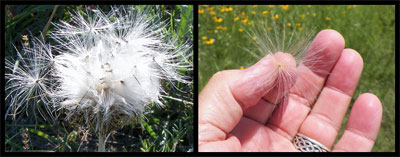
Left photo: Thistle seeds begin to take flight in a Weatherford meadow. Right photo: At least 64 bristles give this single thistle seed the ability to travel for miles.
Turns out that chory/choric is a suffix to describe many kinds of seed movement. Hydrochoric seeds are moved by water, barochoric seeds by gravity. Zoochoric seeds are spread by animals, but we need to know if they are spread on the outside of the animal, like sandbur, beggar’s lice, and devil’s claw (epizoochoric), or inside the animal, like apple, grape, and sugar hackberry (endozoochoric). Scientists even need to know what kind of animal moves the seed: ornithochoric (birds), entomochoric (insects), myrmecochoric (ants). It gets a little fun when you get to chiropterochoric (bats), malacochoric (molluscs), and even crystallochoric (glaciers) seeds. And then there’s seed movement by people: anthropochory. (Hmmm … this could get personal: Chambleeochory … Sperryochory … Mastergardenerochory … Mowerochory … Weedeaterochory … Fordochory … Buickochory ….)
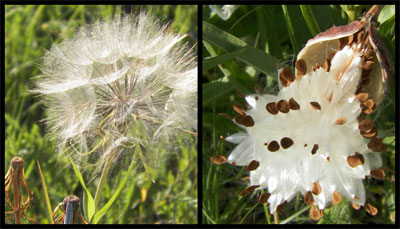
Left photo: Western salsify has an infructescence that resembles a giant dandelion. Right photo: Seeds spill forth as this milkweed capsule opens.
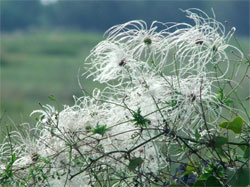
Perched atop a fence line, this clematis sends seeds off to their destiny.
All of this is interesting to a point (sorry I passed that 200 words ago), but I’m still wondering if plants can fly using their own power. My mind goes back to 1999, when Prince was partying and the impending disaster of Y2K was on everyone’s mind. I was sitting on the porch of that little yellow house on DeVitt Avenue near TCU. I had ripped out the lawn and planted a low-maintenance xeric garden, so I was feeling pretty smug as I read the newspaper and watched the neighbor sweat his brains out mowing his lawn. Halfway done, Dave looked over at me for a moment, and I quickly raised my glass of iced tea up, smiled broadly, and gave him a nod as I took a long, cool drink. He returned a scowl and went back to mowing. I felt the warm glow that comes with showing your neighbor that you are smarter than he. (I know, I know, it’s a guy thing.)
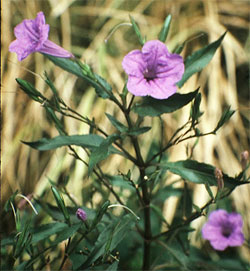
Mexican petunia in flower.
Suddenly, something tiny pinged my newspaper. I looked up, and the only thing above me was a freshly painted porch ceiling. A minute later, another ping. Then another … and another. Finally, I saw this pinhead-sized cannonball fly onto the paper … from the garden. I looked over and saw nothing out of the ordinary until I noticed the Mexican petunia was full of small, cigar-shaped seed capsules, several of which were open. I went over to the plant and touched one of the unopened capsules. Twink! It popped open and shot seeds all over the garden, including the porch, which was about 12 feet away. I thought this plant’s natural seed ejection (ballochory, don’t you know, after “ballistic”) was the coolest thing I had seen in a long time, so I touched another. Whee! I was on number seven or so when the consequences of what I was doing finally hit my brain — each capsule contained about 100 seeds … and there are 15 open and perhaps 15 unopened capsules on this one stem of one plant … six plants, each with about 10 stems –cowabunga! I’ve never been a math guy, but even I could figure out where this was going. I ran and got my pruners and was gingerly cutting off each stem and placing it in a paper bag, all the time begging, pleading for the remaining capsules not to explode as I cut them, when I heard a voice from across the street. I hadn’t noticed the lawnmower had stopped.
“Talking to your plants?” hollered Dave, with a tinge of pleasure in his voice.
“Something like that,” I responded without looking up. Capsules were popping like popcorn as I tried to be delicate, but to no avail.
A devilish chuckle from across the street carried to my ear, followed by a moment of absolute quiet, during which I could hear the “twink” of yet another capsule exploding and the sprinkling sound of seeds landing everywhere. Then, in classic oneupsmanship style, came a perfectly inflected retort, gloriously delivered with twin swords of victory and condescension, “Over here, I let my lawnmower do the talking.”
By the time I was able to put together some sort of comeback, he was gone. Gone with the wind.
Ten hours after I finished removing them, I could still hear the ballochoric capsules popping inside the paper bag as they dried. The noise had subsided by midnight, which was a good thing, because I sure didn’t want to wake up Dave as I sprinkled all those seeds in his flowerbed.
About the author: Steven Chamblee is the chief horticulturist for Chandor Gardens in Weatherford and a regular contributor to Neil Sperry’s GARDENS magazine and e-gardens newsletter. Steven adds these notes:
It may be hot outside, but it’s always cool to visit Chandor Gardens. Come see caladiums, gardenias, hibiscus, zinnias, and lots more revel in the Texas summer. Go to www.chandorgardens.com for details. Just take I-20 west to exit 409, hang a right, go 2.1 miles and hang a left on Lee Avenue. Head straight 12 blocks and you’re driving in the gates. Call 817-361-1700 for more information.
I can always use another road trip! Let me know if you’d like me to come out and speak to your group sometime. I’m low-maintenance, flexible, and you know I like to go just about anywhere. No city too big; no town too small. Just send me an e-mail at schamblee@weatherfordtx.gov and we’ll work something out.

